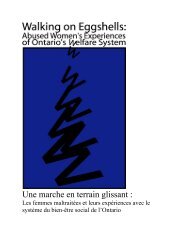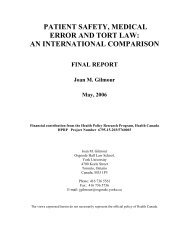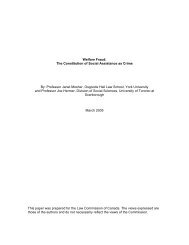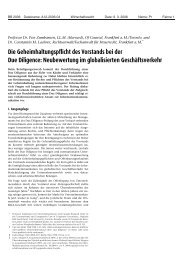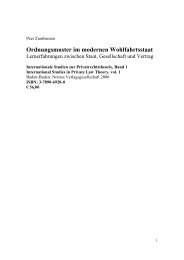Of What Difference? - National Abortion Federation
Of What Difference? - National Abortion Federation
Of What Difference? - National Abortion Federation
- No tags were found...
Create successful ePaper yourself
Turn your PDF publications into a flip-book with our unique Google optimized e-Paper software.
committees. Like many Canadian feministsof my class and generation, I marched incountless International Women’s Day andpro-choice demonstrations. Who can forgethow cold our feet got in those frosty March8 marches on Women’s Day before thearrival of global warming? We marched andcarried signs that demanded the state getits laws off our bodies, repeal abortion lawand drop the charges, again and again andagain.I studied the legal history and context of thecriminalization of English abortion law, thegenesis of the statutory prohibition in 1803,the demise of the relevance of quickeningand the ousting of the jury of matrons, andthe extension of the criminal law’s scopeover the entire period of pregnancy. 29 Istudied the issue of the criminal liabilityof the non-pregnant woman attemptingthe self-induce a miscarriage of a nonexistingpregnancy which took me into thesnakes and ladders of the law of impossibleattempts. But, there was not much ‘action’in the criminal cases—one encounteredabortion in criminal legal historyprincipally in homicide, where a womanhad died, and her lover, friend, doctor,midwife was prosecuted for willful murder.When I turned to social history andwomen’s history, I found a different story.Indeed, it was in the course of this researchthat I learned my most profound politicaland intellectual lessons: to appreciate theimportance of women’s agency and selfdetermination,and the ways in which inthe abortion context they had defied thelaw and medical men: I found the voicesof women who said to doctors, “Nonsense,doctor, there is no life yet…” and “Doctor, Ido not believe it is a crime.” 3029 Shelley Gavigan, “The Criminal Sanction as itRelates to Human Reproduction” (1984) 5 J.30 see Shelley A.M. Gavigan, The <strong>Abortion</strong> Prohibitionand the Liability of Women: Historical Developmentand Future Prospects (Master of Laws thesis,Osgoode Hall Law School, York University, 1984)at 96-97. See also, Shelley A.M. Gavigan, “‘OnThe historical record of coercive andrestrictive abortion law in the Anglo-Canadian context is filled with relativelyfew criminal prosecutions and far moreexpression of women’s resistance. Oneneed think no further in our recent historythan of an ordinary young woman, ChantalDaigle, thrust unwillingly into the nationalnews in 1989 when her former boyfriendattempted to prevent her from terminatingher pregnancy—neither the first nor lastman to attempt to do so, neither the firstnor last man to fail in the Canadian courts. 31During that summer, under the watchfuleyes of an entire nation, Daigle resistedher former boyfriend, the Canadian antichoicemovement, the courts, amongothers. Daigle reminded us that “women’sindividual and collective struggles forchoice and self-determination may havebeen constrained, but have never beenwholly confined nor determined by thelegal and judicial processes.” 32The Contradictory Nature of LawIt was also in this work into the socialand legal history of abortion that I beganto develop an understanding of thecontradictory nature of law, includingcriminal law, and what I later characterizedas the “fragile, incomplete andcontradictory” nature of legal victories, 33including the decision we are invited toreflect upon today. As but one illustration,bringing on the menses’: The Criminal Liabilityof Women and the Therapeutic Exception inCanadian <strong>Abortion</strong> Law” (1986) 1 C.J.W.L. 279.31 Daigle v. Tremblay [1989] 2 S.C.R. 530; forearlier unsuccessful ‘father’s rights’ injunctionapplications in Canada, see Whalley v. Whalley et al(1981), 122 D.L.R. (3d) 717 (B.C.Co.Ct); Medhurstv. Medhurst et al (1984), 9 D.L.R. 252 (Ont.H.Ct.).For a later one, see Murphy v. Dodd (1999), 63D.L.R. (4th) 515 (Ont.H.Ct.).32 Shelley A.M. Gavigan, “Morgentaler and Beyond:<strong>Abortion</strong>, Reproduction and the Courts” inJanine Brodie, Shelley A.M. Gavigan and JaneJenson, The Politics of <strong>Abortion</strong> (Toronto: OxfordUniversity Press, 1992) 117 at 146.33 Ibid.30



